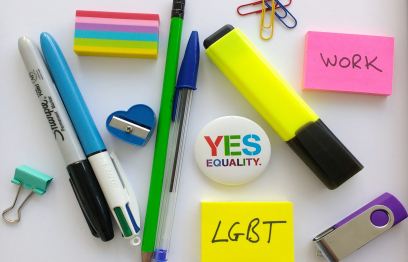
10 October, 2024

Niamh Kavanagh
Posted: 25 May, 2017

Niamh Kavanagh is a Government of Ireland Postgraduate Scholar based at Tyndall National Institute. She joins us today to mark our #LoveIrishResearch theme for the month of May ‘Pride in our Research’.
Over the last 20 years there has been massive social and legislative progress for LGBT people in Ireland, resulting in legal protections for LGBT employees such as the Unfair Dismissals Act, the Parental Leave Act, the Employment Equality Acts, the Civil Partnership Act and the Gender Recognition Act. However, legal protections do not guarantee LGBT inclusiveness in the workplace. There are currently 177,000 LGBT people working in Ireland, according to the Cork LGBT interagency group. LGBT people make up one of the largest minority groups in the workforce, especially in STEM-related (Science, Technology, Engineering and Maths) fields. Support structures tend to focus on more visible minorities, such as those related to gender, race or age. While these groups also include LGBT people, an LGBT orientation or identity in itself is inherently less visible and so, often over-looked.
This invisibility is heightened by the fact that many LGBT employees choose not to ‘come out’ at work for fear of discrimination, exclusion or unconscious bias. In a 2009 Irish survey, one in four LGBT employees said they had been verbally abused on the basis of their sexual orientation or gender identity (GLEN & BeLong To). LGBT people must regularly decide if disclosing their orientation or identity will have negative consequences for their career — if an LGBT employee does decide to ‘come out’, it’s not something that’s done only once; coming out is a constant process in the case of new colleagues, new clients or in a new company. Thus, many LGBT people choose to conceal their true selves in the workplace. In a 2013 study, only 43% of LGBT employees in Ireland reported that they were ‘out’ to everyone in work (Out Now Global LGBT2020). Of course, if a person wants to keep their private life private, this should be respected and protected. However, the mental effort of constantly self-regulating to hide a stigmatised sexuality has been shown to substantially increase stress, anxiety, depression and other negative health outcomes (Meyer, 1995, 2003; Pachankis, 2007). This, of course, has knock-on effects for the business too — reducing workplace satisfaction, lowering productivity and increasing turnover.
STEM-orientated workplaces bring their own unique challenges to the table. Research has shown that anti-LGBT bias is particularly evident in STEM-related environments, compared to other professional settings (Cech & Pham, 2017). This may be due the stereotype that persists of a white, male ‘scientist’ and the correspondingly rigid expectations of gender expression and sexual orientation that go along with it (Nassar-McMillan et al., 2011). On top of this, individual identity factors are sometimes considered irrelevant in STEM fields and the illusion of a meritocratic ideal that ‘all that matters is the work’ prevails. For a recent example, 17 May was International Day against Homophobia, Biphobia and Transphobia and to mark the occasion, CERN posted a tweet saying that ‘diversity opens the door to discovery’. This received several comments along the lines of ‘Diversity is irrelevant. Identity holds no sway over enquiry, inspiration, imagination and discovery.’ Now, internet comments aren’t often a fair portrayal of society, but I do think that these serve as good example of existing attitudes within STEM environments. While it is certainly true that race, gender and sexual orientation do not determine a person’s intellectual ability, they may determine the opportunities that that person is presented with.
Diversity is relevant and has actually been shown to be a good business decision because diverse teams have better results, as discussed in a Harvard Business Review (HBR) article by authors David Rock and Heidi Grant. In another HBR article, by Laura Sherbin and Ripa Rashid, they elaborate further about the importance of inclusion, as well as diversity; ‘In the context of the workplace, diversity equals representation. Without inclusion, however, the crucial connections that attract diverse talent, encourage their participation, foster innovation and lead to business growth won’t happen’. Embracing the principles of diversity and inclusion helps to attract and retain the best and the brightest people. If a company wants to remain competitive in today’s global economy, they need to increase recruitment and retention of talent from all demographics. Not only this, but as Apple’s slogan says: ‘Inclusion inspires innovation’ — diverse teams make better products that cater to the wants and needs of the diverse consumer market.
In order to achieve diversity and inclusion, it is important to create a culture where LGBT people feel that they be their true selves in work. This openness has benefits for both the employee and employer. Several researchers have found that LGBT employees who are open about their LGBT orientation or identity report higher job satisfaction, lower anxiety and fewer work/home conflicts (Day & Schoenrade, 1997; Griffith & Hebl, 2002). Also, they can earn more! It was discovered that LGBT respondents who were ‘out’ in safe workplaces earned 50% more than those who were not (Congress & GLEN Guide, 2011). Unsurprisingly, it has been shown that LGBT employees are more likely to be open about their orientation or identity if they perceive their colleagues to be supportive of LGBT people and if their employer enacts LGBT-supportive policies (Ragins et al., 2007). Further studies demonstrate that LGBT-supportive policies and workplace climates are linked to greater job commitment, improved workplace relationships and improved health outcomes among LGBT employees (Badgett, 2013). As the saying goes ‘a rising tide lifts all boats’; revised discrimination policies and more inclusive practices can benefit everyone in the workplace, not only those in minority groups.
Diversity training can be a great first step in fostering a culture of inclusivity; reducing discrimination, exclusion and unconscious bias. Training can improve awareness and encourage dialogue among all levels of employees. Additional factors have been shown to create a culture in which LGBT employees feel that they can safely disclose their orientation or identity (Colgan et al., 2007), such as a feeling of safety within an institution, the presence of an institutional LGBT group and the visibility of other LGBT colleagues (especially in senior positions). Employee groups can be a very effective way to begin promoting change within institutions. These groups can raise awareness of LGBT issues, contribute to enhanced diversity climates and lobby for institutional change. However, it is important to resist solutions that delegate responsibility solely to those within minority groups, such as relying on senior LGBT employees to mentor junior LGBT personnel.
On a personal note, it was in the sadness, fear and feeling of solidarity surrounding the hateful attack at the Pulse nightclub in Orlando which prompted me to come out to my family and start living my life more openly as a proud member of the LGBT community. We exist in all walks of life. We deserve to be respected as people, we deserve to feel safe and we deserve to be protected from discrimination, harassment and hate — especially in the workplace. Most full-time employees spend at least a quarter of the hours in their week at work; no-one should feel afraid to be themselves in that time for fear that their career might suffer. Since 1993, our love has no longer been criminalised in Ireland and this week marked two years since the Marriage Equality Referendum. Employers need to step up and openly support, strictly protect and actively include their LGBT employees. I’ve talked about how it’s good for business but really, at the end of the day, it’s just the right thing to do.
Disclaimer: The opinions expressed in our guest blogs are the author’s own, and do not reflect the opinions of the Irish Research Council or any employee thereof.